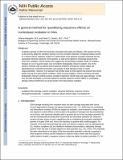A General Method for Quantifying Sequence Effects on Nucleobase Oxidation in DNA
Author(s)
Margolin, Yelena; Dedon, Peter C.
DownloadDedon-2010-A General Method for Quantifying Sequence Effects on Nucleobase.pdf (723.4Kb)
OPEN_ACCESS_POLICY
Open Access Policy
Creative Commons Attribution-Noncommercial-Share Alike
Terms of use
Metadata
Show full item recordAbstract
Oxidative damage to DNA has long been associated with aging and disease, with guanine serving as the
primary target for oxidation owing to its low ionization potential. Emerging evidence points to a critical role for sequence context as a determinant of the guanine ionization potential and the associated chemical reactivity of the guanine, as well as the spectrum of damage products that arise from oxidation. Recent studies also suggest that the generally accepted model of oxidation hotspots in runs of guanine bases may not hold for biologically relevant oxidants. One of the primary methods used to address these important problems of sequence context utilizes gel electrophoresis to identify the location and quantity of base damage arising in model oligonucleotides. However, this approach has limited study to those agents that produce few strand breaks arising from deoxyribose oxidation, while ionizing radiation, Fenton chemistry and other biologically relevant oxidants produce sizeable proportions of both base and sugar damage. To this end, we have developed a universal method to quantify sequence context effects on nucleobase damage without interference by strand breaks from deoxyribose oxidation.
Date issued
2010Department
Massachusetts Institute of Technology. Department of Biological EngineeringJournal
Methods in Molecular Biology
Publisher
Springer Science+Business Media
Citation
Margolin, Yelena, and Peter C. Dedon. “A General Method for Quantifying Sequence Effects on Nucleobase Oxidation in DNA.” Free Radicals and Antioxidant Protocols. Ed. Rao M. Uppu et al. (Methods in Molecular Biology) Vol. 610. Totowa, NJ: Humana Press, 2010. 325-340.
Version: Author's final manuscript
ISBN
978-1-60327-029-8 19